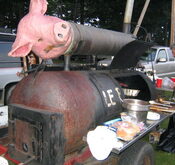The Meat of the Matter: Growing a Food Museum
Making a Museum About Food: Introduction
by Liz Williams, President, Southern Food and Beverage Museum, New Orleans
I am so pleased to begin writing this monthly piece about the making of the Southern Food and Beverage Museum, an undertaking that stems from my lifelong fascination with food and food culture.
In introducing myself, perhaps the most important thing to say is that I was born and raised in New Orleans, where we all live to eat. I was probably nudged further in this direction by being the daughter of a Sicilian mother, and I spent significant time in the kitchen in the company of Sicilian cooks. Raised amidst these two food-loving cultures, affecting me from the cradle, I didn’t stand a chance. Add to that friends in college who introduced me to the joys of Cajun eating, national and international travels, and a cast-iron stomach, how could I help but love food culture?
But back in college, I did not understand that I could study food culture. Knowing that I did not want to be a chef, I did the next best thing--- I became a lawyer. Through the years I lived and practiced in different places, gradually accumulating a range of expertise. I returned to New Orleans and became the CEO of the University of New Orleans Foundation. When I was serving in that capacity, the Foundation opened the D-Day Museum, (now the National World War II Museum, ) and the Ogden Museum of Southern Art. So I learned on the job how to open a museum. Nudged by my life-long fascination with foodways, I decided that a museum that explored that was just the thing for New Orleans. The university did not share my enthusiasm, alas, but I couldn’t let the notion go.
I was the same age as Julia Child was when she began her career in television, so I decided that if I didn’t do it now, I would regret it for the rest of my life. I left my position at the Foundation, and began putting together a museum. Yes, I had been down that road twice before, but this time I had neither the power of the state of Louisiana behind me, nor the backing of a large institution.
Even so, a small group– three of us – to be exact, put our heads together to begin creating this museum. We realized that the principles that applied to the creation of a museum were the same, whether large or small. The difference was our seeming lack of power and of money.
Each month I will be telling the story of how the Southern Food and Beverage Museum, SoFAB, began. What we did to make it happen. What opportunistic situations we seized.
You’ll learn about our false starts, our mistaken assumptions, and how we were thrown for a loop by Hurricane Katrina in 2005. This story is not just mine, I hasten to add. It belongs to some remarkable people who took a leap of faith, joined us in this wild idea and have helped propel us to the point where today, Saveur Magazine has declared SoFAB one of the five great food museums in the world.
In the beginning, in 2004, there were three. Attorney Gina Warner, marketing type Matt Konigsmark, and me. We decided that it was too early to begin dealing with a large board, so we three practical and committed people began doing business over the phone and by email, undistracted by the time it would have taken to reach consensus and mediate group approval. All of us had served on boards before, we had intimate knowledge of how organizations worked, and we were aware that while boards could be helpful, they also were apt to be troublesome. We were out to at least postpone, if not totally avoid, trouble.
Before even naming our enterprise, we had to decide on its mission and scope. We were in New Orleans, of course, one of the nation’s if not the world’s food capitals. We certainly could have decided to build a museum on Creole food, but soon decided that funding such a limited museum would be impossible. We also considered a museum of Louisiana food, allowing us to cover Cajun and Creole foods, as well as the foods from the northern areas of the state. Ultimately we rejected even this idea as still too small, even with statewide focus. 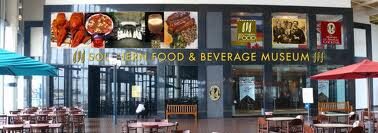
The museum's current spot at Riverwalk
Finally, we decided that the food of the American South did have an international identity. Many of the foods of the Americas that were introduced to the rest of the world as a part of the Colombian Exchange came through what we now consider to be the South. And as explorers ventured west from Europe, they dropped off chickens, horses, pigs, peaches and many other foods here, thus introducing these European and African foods into America through southern ports and pathways.
So, we agreed that we would aspire to be an international food museum that viewed the world of food through the window of the South. At the time we were considering this very basic question in 2004, there was a food and wine institution in Napa, California called Copia that was attempting to combine a food museum with art, cooking and wine tasting. Its permanent exhibit, A Fork in the Road, was an overview of American food through time.
Our motley but food-loving crew decided that since we were located in the South, we could offer a different, highly regional perspective, that would both add to the world’s food heritage knowledge base and also contribute something unique. That is how our territory was established and claimed. ( Editor’s note: Copia, the idea of Robert Mondavi, closed its doors in 2008, having spent lavishly while unable to find the right formula with which to attract visitors.)
With our regional focus established, we moved on to a mission statement. We decided to be soaring and relentlessly upbeat--the museum would be dedicated to the discovery, understanding and celebration of the food, drink and related culture of the South. Yes! Who wouldn’t want to live up to this mission? 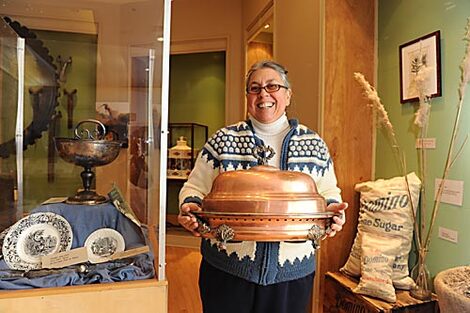
In 2012, our mission is just as relevant as it was in 2004 when we penned it. And I am more convinced than ever that the small board of directors was key to making those early decisions. We were focused and without extraneous agendas. We just sat down and got it done.
So, based in a rich region, yet armed with an international geographic focus, and a grand optimistic mission, what would we name our soon-to-be institution?
What's in a Name? 2
There is a lot crammed into a name. Our merry band of intrepid founders sat around the table on too many occasions trying to think up a clever one for our new creation. Copia, the wonderful wine, food and arts experience in Napa, CA, had a clever name. Other museums that were more focused on a single food could easily describe themselves by using the name of that food. And since we wanted to be an exciting place and not stodgy, we even considered not using the word “museum” in our name.
Naming is tough. “Gastrodome” sounded like a ride at a theme park. “Southern Eating Adventure” sounded like a Chuck E. Cheese type of experience. So we just kept falling back on our working title, the Southern Food and Beverage Museum. It was descriptive, and useful when we talked to people about it, but definitely a mouthful, as well as a lengthy name to write. Ever looking for a shortcut, we started writing SFABM, while we continued to experiment with a single word name or a descriptive name that sounded clever. I wish that we had kept a list, but we kept throwing our lists away in frustration.
Unrealistically, we had hoped that SFABM would yield a pronounceable acronym. Not Soon we began a quest for an acronym that we liked. We would start with the letters and then hope to create a name later that evolved from it.
We tried SOUTH; we tried EATS; we tried FOOD. This activity was a bust, resulting in more frustration. But to make things easier for ourselves, we began to think about the word south and southern as “so.” It wasn’t really cheating since it was a legitimate abbreviation, so our exercise was not wasted. We all kept seeing FAB in the middle of the SFABM written in big letters in front of us. Somehow, in a moment of inspiration, someone looked down, dropped the M, added the little o, and blurted out, “so fabulous.” “This museum is so fab,” said someone in an imitation of a Beatles accent, reminding us of the FAB Four. 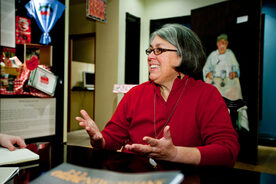
We didn’t all smile and embrace it, at first. A bit corny, a bit cheesy, very esteemed descriptive food-based adjectives! We kept repeating it, “The SoFAB Museum.” That was okay. We decided that we had made progress, and that using this phrase would lock us into the Southern Food and Beverage Museum as a name. And goodness knows, we needed to settle on a name. I remember practicing saying SoFAB frequently so that it felt right coming out of my mouth. In the beginning, I felt sheepish every time I said it, but as it grew on me, so it grew on everyone else.
After a week or two, we had all played around with SoFAB and liked it, and it really did begin to feel right. Today it just rolls off our tongues as though it is the most natural and obvious of names. Full disclosure: We have dropped “museum,”--is there a subliminal message there?--- and now call ourselves simply SoFAB.
Our next step towards creating SoFAB’s identity? Creating a logo.
Logo Time 3
Few decisions are more daunting than choosing the key symbol that will represent the new institution you are creating. I have a certain level of comfort when dealing with words, presumably because that comfort comes from playing with words for so many years. Even in school, writing is given a higher priority than drawing pictures or designing visual presentations. So the search for a logo, akin to creating a coat of arms, was not a comfortable one. We all knew that it was important, however, and we knew that it had to represent food. Our brave and motley crew sat around the table, having become one with the name SoFAB, and tried to become one with a fruit or vegetable or other food stuff.
First, we each began a search of logos, both to look for inspiration and also to make sure that we knew what was out there. We sought something unique, nothing akin to a logo of another organization. In particular, we did not want to copy the style or logo of the Southern Foodways Alliance, because their logo and style is distinctive and associated with an organization with a strong identity. I know that I stared at their charming logo for a very long time so that I wouldn’t think of anything that copied it. ( We were both focused on the South, after all.) Alas, that meant no cast iron pan, no pigs, no corn, no peas, no catfish for us. OMG, what was left?
In the end, we remembered that we all loved okra. We loved its simple graphic impact. We loved that okra was identified with the South. And we loved that it was not, as far as we knew, identified with any other organization. Our graphic designer created several iterations of the basic design.

This is the logo that we selected. It has three okras, known henceforth as the dancing okras. It contains the name of the organization in a bold, modern graphic presentation. And it is not a simple square or rectangle. The top scallop is similar to the perforations on a stamp and also evokes the pinking of an old time paper grocery bag. This green is our primary color and we have a deep orange as a secondary color. Sometimes we bring in an eggplant color to compliment the green. The symbol of the okra can be lifted from the logo and used separately. And we can use the okra in different colors for affect, as we do with our red, white and blue okras for the Washington, DC, Roundtable series.
Below is how we have used the logo plus institutional name, in concert with a sugar exhibit by SoFAB.
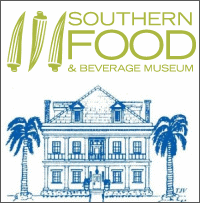 Sometimes we use the dancing okras by themselves. We are rich in options.
Sometimes we use the dancing okras by themselves. We are rich in options.
A good logo should be a strong feature of an institution’s identity, and the dancing okra delivers that for us. Our terrific graphic designer gave us an important gift that we have used every day since she created it. It is a vital part of our identity, flexible and full of variety, yet without any dilution of impact.
With a name, a mission statement, and a logo, we were ready to go forth and make Southern Food and Beverage, SoFAB, into an institution. We had delusions of grandeur, also known as aspirations. We also knew that we had to take those first steps. . .
The preliminary matters behind us, we began to talk about what we were doing. I remember excitedly telling people that we were going to open a food museum named the Southern Food and Beverage Museum. What a great idea, right? To open this museum in New Orleans, where people already come to eat wonderful food. Eating is as important a tourist activity in the city as visiting the historic buildings, drinking on Bourbon Street, or listening to music. But---- instead of sharing my excitement, most people stared at me and asked, “What is a food museum?” This was an unanticipated problem. We were so immersed in the museum concept that we failed to realize that what we totally and completely envisioned was not at all clear to others.
By now, we are well prepared to answer the question--what is a food museum?--- over and over again.
Most people are familiar with the concept of an art museum. Even those people who haven’t been to an art museum since a high school field trip still understand what one is. There is no need to explain it. But most people have never been to a food museum, and most have not even heard of one. We endured questions about frozen food, kitschy displays of old packaging and old utensils, spoiled foods, and statues of asparagus and cauliflower. No, we were not a museum of aging foodstuffs. Our food museum might have an exhibit that contained an old package or faux food, but its purpose was to explore cultural foodways and history, not used food.
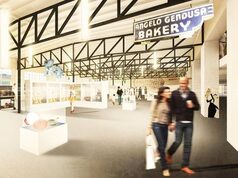 Groundbreaking for the new, 30,000 square foot Southern Food and Beverage Museum took place in June. The new facility aims to open in March 2013.
Groundbreaking for the new, 30,000 square foot Southern Food and Beverage Museum took place in June. The new facility aims to open in March 2013.
We definitely were not ready to open, as we had no collection, no plan, no location, and no money. So naturally, we decided to open. Just one exhibit on a temporary basis in borrowed space, mind you, in order to demonstrate just what a food museum could be. One exhibit would allow us to focus our efforts on a single idea within a limited space.
We located a vacant shop in a downtown shopping center and were able to obtain it for 90 days. Since we were in New Orleans, we chose the low-hanging fruit--- beverages associated with the city. We called the exhibit “Toast of New Orleans,” and focused on alcoholic drinks like absinthe and cocktails, as well as non-alcoholic liquids like coffee and chicory and nectar soda. I asked someone I hardly knew if she wanted to be the curator on a volunteer basis. Amazingly, she agreed. This was Elizabeth Pearce, now fast becoming a cocktail celebrity in New Orleans. We planned the exhibit, asked people for money, requested artifacts from many sources, and tried to create a professional level exhibit on a shoestring, and without any experience. Like everything else, we made it up as we went along. I have often thought that our utter lack of training not only made us creative, it made us fearless. We had no idea what we couldn’t do.
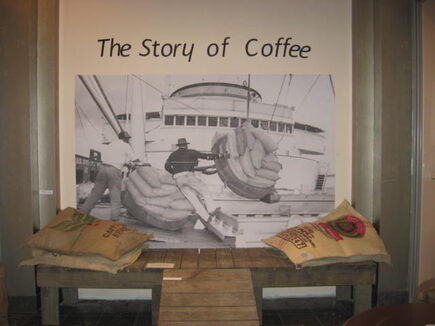
"New Orleans remains the #1 coffee port in the United States, the United States is the #1 coffee consuming nation in the world, and New Orleans is the largest consumer of coffee per capita."
People were incredibly generous. Apparently our enthusiasm was infectious. People lent us precious memorabilia from their parents and grandparents, and allowed us to copy their photographs. People gave us paint and supplies. Other museums lent us display cases. Restaurants and bars provided food and drink. We were so indebted to so many for their kindness and their trust.
With as much splash and brio as we could muster, we opened our first exhibition. We were mentioned in USA Today, and we staffed our museum with an intern who was enrolled in an Arts Administration program at the University of New Orleans. She was very pleased to be in a role that allowed her to learn absolutely everything. We created exhibit hours around her schedule, because all of the rest of us were working.
And we were thrilled when people actually came to see what we had created. An invitation from the Louisiana State Museum to reinstall the exhibit at the US Mint in New Orleans was a true validation for us. A “real” museum thought that our exhibit was good enough to grace their space. It also gave us a tangible way to explain what we wanted to do.
While our exhibit was open at the Mint, we began to narrow our list of possible permanent locations, and started planning a second exhibit for a different space. We worked on a website and a newsletter for SOFAB, as we cast a net to draw in as many people as possible.
The Bigger Picture 5
While the Southern Food and Beverage Museum was busy trying to establish itself in New Orleans, the founders were also trying to create awareness, interest, and support for it in the larger culinary community. Yes, we were a Southern museum, but one with national and international aspirations. We also were local, creating exhibits for display in New Orleans. And working to create a physical museum in the future, in the same location.
So, broadly, we wanted both the region and the world to care about us. Creating the regional connection was the first step. In order for people to feel invested in us, we decided to create a menu collection to which Southerners or those with Southern connections could contribute.
Menu collections are often idiosyncratic. Perhaps a person has collected menus from restaurants where anniversaries have been celebrated. Perhaps the menus are from a grand tour. Regardless of their origin, once donated to a library or archive they form a record. But creating a cohesive whole from the random collections of various people is a real challenge for most archives.
We decided to try to define the collection. And, of course, we made our play for megalomania. We would collect menus from every restaurant in the South. Any type of restaurant would count, based on the idea that if you eat it in the South, it is Southern food. And we would also collect menus from outside of the South – both US menus and international menus – that purport to serve “Southern food.” That would allow us to see what people considered to be food of the South. We wouldn’t worry about duplicates, because that would give us a way to study a particular restaurant over time.
Soon restaurant associations and food editors knew that we were collecting menus. Articles began to appear in newspapers, and the story was even featured on NPR. People all over the South began to be invested in us in a small way. And we began to learn what restaurants served.
Menu from the Southern Restaurant, Chattanooga, TN
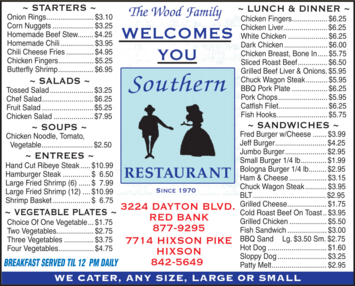
Collecting menus in this organized and systematic way, though we are not yet fully digitized, has given us a precise record and methodology for collection. It will make the cataloging of the menus, the prices, and the details both easy to accomplish and easy to search. By trying to collect something ephemeral that was actually accessible and inexpensive, we began to create an important culinary record, and belatedly congratulated ourselves on being fiendishly clever...
Amazed by what we were learning from menus, we expanded our collecting to include relevant business cards, matchbooks, and other ephemera that represent Southern restaurants, ( Even in the short time that we have been on the hunt, we have secured menus and postcards from restaurants that no longer exist. )
Today we also have vintage menus that people have discovered in drawers and attics and donated to us. We are now the beneficiaries of an expanded collection of menus, but our core is the contemporary menu.
We approached all of this with one goal –-- to help us reach out into the entire South. The incidental effect of this menu idea is an infrastructure and a leg up in creating an archive, as well as a collection of books. We also have an introduction to and insight into every state. We are documenting dishes in every southern state in a way that we could never had anticipated, nor even planned for.
With exhibits underway, and a burgeoning collection to handle, it was really time to establish a location. We had to become something. No longer a promise, we must become a genuine museum.
But Where to Put It? 6
It was time for SoFAB to fish or cut bait. We had created an identity for the museum, we had amassed a group of supporters, we had created some buzz, but we were not yet a reality. Unless we made the museum real, we were concerned we soon would lose our impetus, and our followers.
So. We decided that we needed about 20,000 square feet to have room for exhibition space, a demonstration kitchen, a museum shop, office space, and a staging area. We had accumulated some money from donations, memberships, and grants. Not enough, by any means, to purchase a building, but enough to set up in rented space.
Thus began the tedious task of trying to find a space that would allow SoFAB to be a real destination, to realize our dreams of a museum about southern food. We had numerous false starts, some of which, unfortunately, were documented in the newspaper. New “celebrities” in town, we were learning that both successes and failures were newsworthy. But still, people were interested. And our stumbles may have made us more appreciated, rather than less. ( Our success has not been without hiccoughs! )
Finally, Hurricane Katrina and her aftermath provided an opportunity for us.
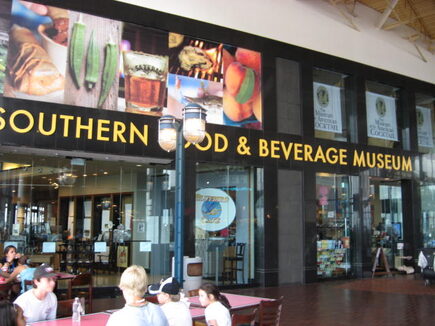
SoFAB's first home in New Orleans, at Riverwalk
The Limited, the women’s clothing store, had been a tenant in the Riverwalk Marketplace. After the city reopened, The Limited did not return. This left a 14,000 square foot store unoccupied. We were able to negotiate an extremely favorable rate with the mall management, along with a 5-year lease. It was a good fit for both SoFAB and the mall. We marketed ourselves, bringing new people into the mall, and many of the other mall tenants did not. And we were able to incubate our fledgling museum in a space that did not require major outfitting.
It certainly wasn’t perfect, but no situation is. We were in a Catch 22 situation. We had less money than we wanted because we weren’t open. But we weren’t ready to open properly. But-- without operating, we weren’t earning any money. So we had to take that leap, even if the space was not as big as we ideally wanted, which meant that we wouldn’t be able to do everything that we had envisioned. The five-year lease meant that certain investments weren’t really financially prudent, because the money would not be recovered if we had to leave at the end of the lease. ( Most museum grants, incidentally, require that a museum be open for two years before qualifying.)
To sum up, we were utterly unprepared to open SoFAB. So we did.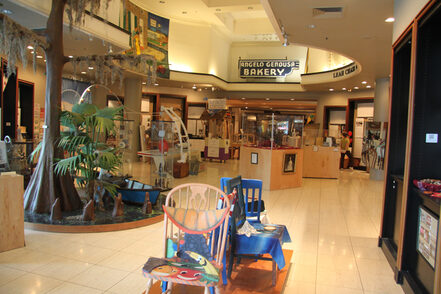 Photo via New Orleans
Photo via New Orleans
Our vision was curtailed by space limitations, but that made us more focused. We could concentrate on doing what we could do. And it turned out not only was that a lot, it was enough. The externally enforced focus definitely helped us succeed.
So after signing the lease, we began to plan our opening, our exhibits, and our shop in earnest. We picked an opening day and began to publicize it. Working with fevered dedication, our staff poured their hearts and souls into the work of opening SoFAB.
Once we opened, a burst of enthusiasm pushed us on, thankfully---my biggest concern had been that a letdown in drive after the big day would stall us---but the opening event was the beginning, not just the big event. There was a brief letdown, sure, but there was so much to do we just kept going.
Growing Up 7
I remember the first time someone called me “Ma’am.” I was in my 20’s. As I looked at this child talking to me, I thought “I am way too young to be “Ma’amed.” But then I realized that I was seen as an adult by children, and that I was actually all grown up.
Something like this happened to the Southern Food & Beverage Museum group. People began to call us and ask us questions about food history and see if they could study our artifacts. They asked us all sorts of things, as though we had been around for years, as if we actually knew something.
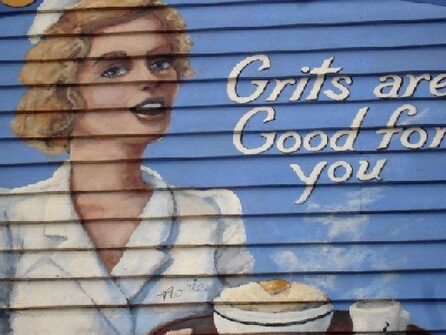
Everyone assumed that we knew what we were doing. While being taken seriously, we were laughing up our sleeves like adolescents, because we knew that we had made it all up! So---we were forced to grapple with the fact that despite having made it all up, “it” was working.
First, we reminded ourselves that even the Louvre in Paris had started one day, and had not been open the day before. Just because a place had longevity didn’t make it better, only older. That museum across town that made me jealous had been around forever. It had systems in place, a depth of artifacts and art, as well as supplies and resources that it had accumulated over the years.
Every time SoFAB did anything, on the other hand, we were forced to be inventive, while lacking resources. But we struggled through. The general public only saw that with each visit we had more on display, we had a more polished appearance and we were more and more comfortable with ourselves. Like “dress for success,” we began to act like the institution we wanted to be.
When you select an Opening Day, you have to open on that day, ready or not. So we opened. But some of our text panels contained typos (we put them up anyway and replaced them later,) and one of our borrowed exhibits didn’t arrive until days after the opening. In spite of that, we received generous gifts of artifacts from people who visited the museum. I found artifacts on my doorstep at home. Some were even left in front of the museum. People called to donate family cookbooks, interesting appliances and cooking tools, and crazy things that we needed to create our displays. The generosity of people and their desire to be part of the museum made us realize what a huge responsibility we had undertaken, in order to preserve these family treasures.
Often what we collect in the food museum world is really trash. We have old packaging which is generally discarded. We have kitchen tools which are obsolete, and often discarded as they are replaced. We have appliances that have seen better days and pieces of furniture that have no meaning in a modern home. Maintaining our collection is not the same as maintaining priceless works of art. We are maintaining priceless trash, but I think that it has value, and tells a story that must be told. But much of what we save was made to be thrown out.
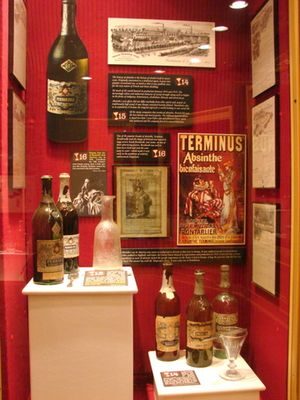
Our understanding of the importance of maintaining these artifacts coincided with our growing up and the realization that we are really an institution. Not only do others believe that we will go on to be a continuing institution, but we know that it is true.
Today we operate on several levels. Level one is the day to day. We know what has to be done to keep the museum running and good- looking for visitors. On the second level, we must be thinking about the short term future, getting ready for new exhibits and planning programs. Level Three is where we think about the long- term future, asking what we want to be doing, and positioning ourselves to get there.
Because we are thinking of ourselves as an institution that will be here 25 or 50 years from now, we can focus on our personal roles, what will be needed in the future, and how SoFAB will go on.
This transition from thinking we were committing fraud to believing that we were creating the future marks our growing up. I can now say that we are an institution. We have grown up.
Open! 8
Okay. We are open. Now the work begins, one day at a time. We open every day, we make sure that the light bulbs are changed. We make lists of all of the things that we meant to do for the opening that we hadn’t gotten around to. And we begin to attack our primary list.
First off, we corrected and reprinted the explanatory panels that contained typos and other inaccuracies. That helped a great deal, because visitors were pleased to point out our errors!
After our first week we began to relax into a routine, deciding to make some improvement each day. In the beginning there were not only many donations of artifacts, but also almost everything that we received enhanced our displays. We added new artifacts as we received them. This was important in several ways. First, it signaled to all who visited us more than once that we were always improving. And because the museum was not static, people felt encouraged about returning. There would always be something new to see. This in turn also motivated even more people to donate artifacts, so we realized we had created a positive cycle.
By improving and adding new artifacts we also fleshed out what was at first a rather spare museum. While some museums are intentionally spare and spartan-looking, that just didn’t work for a food and beverage museum. It seemed empty, not modernist. We discovered that people actually want to feel overwhelmed with artifacts and exhibits. That’s a lesson that we still keep in mind. Spreading out artifacts so that they can be thoroughly examined, a notion we thought made sense, apparently made people feel that the space was too empty.
Eventually, I learned how to let the artifacts tell the story. Our museum started with many explanatory panels and I wanted to find the balance between the skimpy labels in some art museums, and the lengthy, detailed writeups that deliver more than most visitors can handle. We have supplemented our panels, of whatever length, with QR codes that play additional material on visitor cell phones. But everything from Twitter to texting has made us focus on breaking down the important information into shorter narratives. It is far more inviting to browse the shorter narratives than it is to come to a full stop to read a tome.
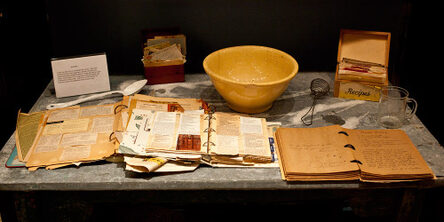
Photo via Serious Eats
Good food exhibits overflow with vignettes, props, imaginative presentations and a density of stuff. In the future, when people can eat delicious food in the museum, we will step to the next level. We are already thinking about garbage cans and other practical solutions to controlling the obvious downsides to eating in the museum. But we cannot be a food museum and hold our heads high, if we do not provide food, and let people eat it.
We also made progress in answering our visitors‘ questions. What is there to see in this museum? Why should I visit this museum? What is a food museum, anyway? We were proud as people left the museum and said it was neat or interesting or really awesome. When people stayed for hours we gave them passes to return the next day. We began to ask them for artifacts and menus and cookbooks, and many people actually sent us their treasures.
We began planning new exhibits, along with weekly programs listed in the newspapers, and on line. And at some point we transitioned from a start-up, really a fledgling, museum to a fully fleshed-out institution. When did that happen? Who knew, exactly? But it did happen. Now we could envision expanding our reach, and looking to the future, even as we continued to chip away at the long list of things that had not been completed before opening. We are still at it, one day at a time.
Money Matters, It Really Does 9
Our museum is open. We are improving our exhibits, the collection is growing, we’ve established a newsletter, created some programs, and we are welcoming actual visitors. So now... we have to address the constant and underlying problem of all nonprofit organizations – money. MONEY.
No matter how frugal and creative you are, it takes money to stay open. Many important museum components are unlikely to become profit centers. And most museums cannot earn enough through entry fees and gift shop sales to eliminate the need for additional funding.
For example, if you were to monetize your collection by charging other institutions or researchers for scans of photos, use of the collection’s artifacts, etc., you might collect a bit of money. But is that the purpose of the museum? What about education, sharing information, and open access? If the department is not a profit center, the people in those departments-- the registrar, the collections manager, even the curators-- are a drain on the resources of the museum.
Money is crucial to doing any kind of business. Although I am a believer in frugality, imaginative use of resources, recycling and reuse, as well as begging, these qualities are not enough. Money is still necessary. It powers the museum. So in spite of the fact that building the exhibits, doing programming, meeting interesting people, collecting artifacts, and all of the other aspects of running the museum are more fun than raising money, we MUST raise money. We must raise it all the time.
How to raise the money the museum requires becomes more and more important. We must constantly create priorities for fundraising time, and we must ensure that sponsors are not advertisers, and that they are not exclusive. All of this is tedious work. It is almost never fun. But it is imperative that we relentlessly pursue money.
Since I have been writing this tale of founding a food museum with somewhat of a light touch, I tried to describe the money thing in the same tone. But I don’t think I can. I fear that if I do not emphasize the relentless dedication to finding money, that must go on all the time, I will give the impression either that it is an easy task (which it most decidedly is not) or that it is not really important.
Whether the income is earned from gift shop sales and entry fees, rentals, special programming, fundraisers, grants, gifts or sponsorships, it is all essential. We cobble together the money that we need, and we don’t spend more than we have. We benefit from donated services as much as we can. Every technique is important. We reach out to funders so that they feel good about supporting us. We thank them and appreciate them, and then thank them again. And then we hope that there will be sufficient funds for the fun stuff.
We are even reaching out to you, dear foodmuseum.com reader, because you, too, can support SoFAB by becoming a member, by signing up for our newsletter, by following @NittyGritsWords on Twitter, by sending us menus and ephemera for our archives, by sending us books for our library, by sending us artifacts, and, above all, by sending us, you guessed it, MONEY!
Collections: We'll Take Everything... 10
Our visitors tell us what we need to know. They want to see stuff, lots of it. While some of them are willing to read lengthy panels with explanations, and others will listen to descriptions by scanning a bar code, some people are impatient with reading. And no one wants to read a book standing up, moving from panel to panel. People who have come to a museum want to see stuff. And we aim to please. We want to share our stuff with them.
So while the first and obvious question is --“Where do you get the stuff?”--an embarrassment of riches – a polite way to say that we have too much stuff – does not follow too far behind. When people want to unload their boxes of stuff, it helps to have a policy that guides our response to their generosity. The policy will have to develop and change, of course, as the museum grows and changes. But a guide that helps at each step along the way is a big help. Having a policy allows everyone at the museum to know how to say “yes” or to say “no,” when necessary.
In the beginning, when our walls were somewhat bare and our shelves were sparsely populated, we were happy to take everything. People often left things on our doorstep. They would press on us a box full of items when we only wanted one thing in it. And because we wanted that one thing, we would take the entire box. But then we had to have a policy for dealing with all of those extra things in the box, many which were not relevant to us.
Soon, we had to decide what we would collect and how...
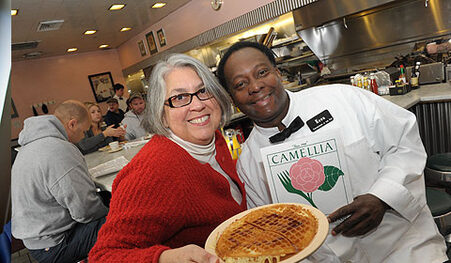
Liz Williams at New Orleans' 65-year-old Camellia Grill Photo: Cheryl Gerber
I will be the first to admit that we are very liberal about what we collect. Because we are one of the few institutions collecting the material culture of food and drink, we decided that we would be liberal about our collecting practices. We collect artifacts as well as items for educational purposes and for props in our exhibits. And of course, we have to consider the space requirements that each donation requires, and balance that against the importance of the acquisition.
Two years ago we took possession of 12,500 beer bottles. ( I have used this donation as an example of our garbage collecting. ) Clearly these bottles, most from a pre-recycling era, were made to be thrown away. But now we own them, each cataloged and dated. They span about 70 years of brewing and document the changes in brewing history. The history of many breweries, some of which have closed, the changes in bottles, and the changes in capping.
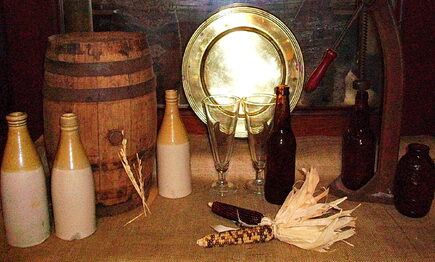
The collection, which we continue to add to, is a better document than a catalog comprised of drawings or even photographs. The bottles will lend themselves to interesting live exhibits, as well as imaginative on-line exhibits, and even just decoration within the museum. 12,500 beer bottles, plus what we have gathered after receiving that core collection, occupy a great deal of space. But we decided that it was worth it. We are moving to our new space, and our dedicated volunteers have clocked days of their time moving all those bottles.
Another major consideration is how to deal with actual food. We have received cans that are old and that still contain their original contents – sometimes food and sometimes drink. We also have jars of food that were home canned. And we have cans and bottles of liquids. These things are artifacts.
For educational and demonstration purposes we maintain raw sugar, bagasse (pressed sugar cane), jars of dried beans, jars of grains, herbs and spices, and dried pasta. And we have the famous and beautifully decorated cakes that make up the cake museum.
So ours is an interesting twist on collecting. We certainly do not want to attract either rodents or insects, nor do we want rotting food in our exhibits. We want things to be attractive, not shriveled and dead. While most museums worry about live flowers and write policies about those flowers, worrying about food is yet another magnitude of concern. So our policy must include a statement about things that may contain food. We have decided, for example, not to extend our collections to freezer units that could maintain what might be described as historic food or meals associated with a famous person or event.
We recently discussed attempting to reconstruct historic tastes. If we could save those foods through the freezer we might come close, in the future, to tasting the past with some accuracy. It’s an interesting concept, but that is a job for another institution, not ours.
We are also grappling with questions about what tools we can actually use in demonstrations. There is great educational value is demonstrating how old tools were used, but continued use can cause deterioration. This has led us to the decision regarding small tools. We collect them in multiples so that we can preserve those in excellent condition as artifacts, while using the others for demonstration and education purposes.
Yes, we determined, our mission is to collect. When in doubt, we accept. We also scrounge, beg and scavenge. Our board, our staff, and our volunteers all participate. If you have something southern food-related in your garage, in an uncle’s basement or if you see something on the side of the road, let us know. You may have a treasure, and we may want it.
Are We There Yet? Bucking The Learning Curve of a Museum about Food 11
A food museum is not in the experience of most people. After all, museums dedicated to food are few and far between. As we’ve said before, people know what an art museum is, but comprehending what a food museum might be takes time and exposure. From the beginning we at Southern Food & Beverage Museum mounted exhibits to let people understand what we planned to do. And slowly the locals have been won over after visiting us. They have begun to get it. They know what we are. SoFAB actually makes sense to them.
But outside of the few who already are interested, and the people who have visited us, we remain an unknown concept to the many. The many, unfortunately, includes people who run foundations, government agencies which could support us, and those who might potentially visit us. Now that we have five years of operation under our belt, it is getting better, but a food museum is still not a household concept. But today many mainstream museums have mounted exhibits about things culinary. For example, the American Museum of Natural History is currently presenting “Our Global Kitchen: Food, Nature, Culture.” This helps SoFAB since we are presenting aspects of that concept all the time.
Eventually we will be such a part of the landscape that people will react – sure, great place – when they hear mention of us. We will be the institution that people think about when they think of a place that is a food museum.
We will have the intellectual heft, great resources, fabulous exhibits, gardens, restaurant, bar, demonstration kitchen, great children’s programming, international reputation, library and archives, outstanding collections, awesome educational programs and resources, great media resources, and so much more.
Right now I am a bit tired, as we are poised to move into our own building after only five years in existence. ( Our first location is now closed.) I try to be upbeat and somewhat wry in these posts, yet today I admit to feeling that I am pulling the planet uphill. The unanticipated issues of our move to our own building are extremely daunting. We are growing so fast that we are opening not only a museum, but also a library. We are bursting with success, however, so the tiredness is good.
A taste of recent success:
* Farm to Table International Symposium Producing Partner
* Winner of the Louisiana Historic Preservation Heritage Award 2013
* Home to one of SAVEUR magazine's "Five Great Museums Devoted to Food"
* Culinaria Queries around the country
Along with numerous donations of various kinds that we have received.
Maybe years from now I can reread this post and remember the exhaustion, mixed with excitement, frustration, impatience, and gratitude to so many. It makes me smile as I nod off.
I have written many words and filled much space in previous entries talking about the how-to of starting a food museum. Of course, I am really telling my own story of starting the Southern Food and Beverage Museum, now a division of the SoFAB Institute. Yet I have never talked about how exciting it is. I work all the time, and it never feels like work.
I am so lucky. 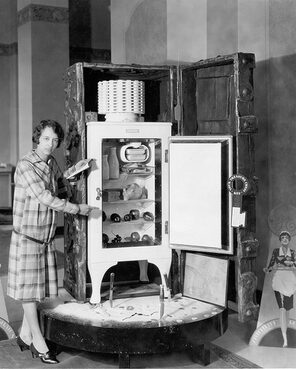
Sometimes SoFAB reminds me of the magical library created in the Librarian series featuring Noah Wylie--you may have seen it on TNT. A young librarian discovers that his library houses astonishing artifacts like Pandora’s Box, Excalibur, even the Ark of the Covenant, items central to the world’s mythology.
SoFAB has the equivalent of these artifacts in the culinary and drink world. OK, I exaggerate slightly, but we have assembled so much in such a short time. It all needs to be saved and we are doing it! ( I am convinced now that we do not want to have any sensible policies about accepting donations of artifacts...)
Just recently we received a collection of Fiesta Ware, a treasure of Coca-Cola memorabilia, and wonderful gifts of rare pamphlets. A beautiful example of a 1929 General Electric refrigerator came our way, too, in very good condition. We were excited to receive it. Then, about three months later, someone gave us a box of old pamphlets, several from nationally marketed companies like Jello. Others represented regional companies like Three Little Pigs sausages and Trappey’s. Also in the box was a copy of the recipe book that was given out with General Electric’s refrigerators.
A lovely volume with instructions on how to make ice and use the refrigerator to not only preserve foods, but to chill and enhance them, it’s an early example of how to use technology to make more interesting food. We were thrilled to marry the object, the refrigerator, with the book which contained insights into how people thought about this once modern appliance.
But the magical part is that even before we had received the refrigerator or the book, almost a year earlier we had received an electric clock in the shape of this refrigerator, marked General Electric. Though not made by GE, these clocks were premiums given out to purchasers of the new fridges.
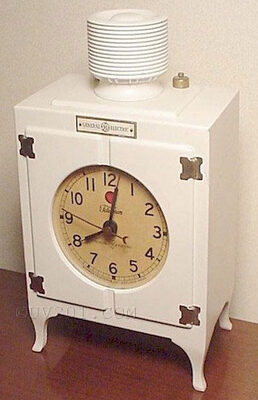
Imagine the special feeling when all three of these items, received at different times from different sources, were united in the museum. It reminded me of the other- worldly happenings in the Librarian series. The feeling of awe that the Librarian expresses is precisely what we experienced at SoFAB. And the longer we are open and the more people know that we exist, the more often this type of magical experience seems to happen.
Increasingly our collections are becoming more varied. We collect books, menus, pamphlets, papers and other ephemera, photographs, and art, as well as kitchen appliances, tableware, flatware, glassware, kitchen tools, and pots and pans. We seek out agricultural tools, fishing tools, and other means of producing food. We welcome linens, packaging of all sorts, restaurant and bar equipment, signage, and all sorts of ephemera. The opportunity for us to be awed and amazed simply grows. Last week someone gave us two rolls of 1950s shelf paper still in the original wrapper. Could anything be more cool? We’ll find out when the next gift arrives. We have Tupperware, old matchbooks, Corning Ware, even walking jiggers, yes, jiggers with feet. We even have several bee hives saved from trees.
And our adventures - now occurring around the country - as we retrieve these treasures, and the places that we eat and the people that we meet are an even more meaningful and joyful part of the story.
So now you know. Despite our moments of despair and and deep exhaustion, the ongoing creation of a food and beverage museum is a wonderful, important, rewarding undertaking.
Photo Via
Creating a Culinary Library 13
Early on in the establishment of the museum we knew that we wanted a library. At first we just thought we would need a small library for our occasional food research, just an in-house place to use close at hand. I had my own books, of course, which were the ones that I used frequently and those that I had accumulated during various research projects. And I had a tendency to buy food books whenever I could.
But then we were offered a library of cookbooks by someone trying to do something positive for the museum. And soon after that, other people offered us more books. As a part of our early partnerships, SoFAB was working with the museum studies program at a university in the city. The students were learning to inventory and catalog artifacts, so we left the books with them.

This was in the summer of 2005, a year that may ring a bell. Our books were at that university when the city flooded in the wake of Hurricane Katrina, after the collapse of the federal canal walls. We were not able to return to pick up the books for some time, and after three weeks under water, the books became pulp. The computers with the inventories were ruined, too, as were our back-up inventory records.
Friends from all over the country heard about the loss of our books and began a campaign to help us replace them. Many people in New Orleans had lost their cookbooks as well, during the flooding, along with a range of personal and treasured family recipes. During this process we realized that we really needed a library of books, an archive, and a place to keep community cookbooks. We came to realize that the library and the books were not merely a means to research, but were artifacts in and of themselves.
Today our library contains about 12,000 volumes, thousands of menus, pamphlets, and other materials. We have rare and vintage books, books that describe the food and drink culture of the past, books about catering and restaurants, nutrition, agriculture, fishing, and books for children.
On Saturday, September 21, 2013 we held a sneak preview event at the soon to open SoFAB Culinary Library and Archive. It was a rainy, ugly day and we had a big crowd and a great program.
On October 30 we will formally open the SoFAb Culinary Library and Archive in partnership with the New Orleans Public Library. We will become the NOPL’s Culinary Branch---we think that we may be the rare, maybe the only public independent culinary library--- and to access our material all you will need is a library card. You will find the SoFAB volumes on the NOPL on line catalog. You can watch our progress and our programming on the SoFAB Culinary Library and Archive Facebook page.
Our collection is in multiple languages, it is old and new, and it is open to home cooks, culinary students, bar flies, fishermen, farmers and academics. I hope that you can join us to open our growing library.
Academic credentials have never loomed large as far as the considerable talent at SoFAB is concerned. Though an attorney, I certainly did not know how to open a museum, write about food, or open a library. Looking back on my career and trying to order it to explain how I came to be where I am today, I can say that everything that I have ever studied or done has coalesced into my current job. But my path was not a straight and directed one. Being a lawyer helped. It had taught me to become an instant expert, ready to cross-examine experts. But sometimes having specific training can make a person more limited and narrowly focused. An untrained person doesn’t know what the limitations are supposed to be.
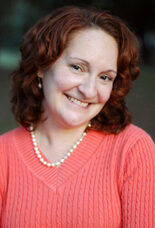 The first curator of SoFAB, Elizabeth Pearce, is an actress and singer. She used her storytelling skills and her experience working with minimal props and sets, to tell a story with artifacts. She broke all sorts of rules in her labeling and she used props and photographs to excellent advantage. I have certainly learned a great deal about creating a story arc for artifacts from her. With no background in either design or museum studies, Elizabeth was an intelligent person who marshaled her skills, problem-solved her way out of budget problems, and invented what needed to be done.
The first curator of SoFAB, Elizabeth Pearce, is an actress and singer. She used her storytelling skills and her experience working with minimal props and sets, to tell a story with artifacts. She broke all sorts of rules in her labeling and she used props and photographs to excellent advantage. I have certainly learned a great deal about creating a story arc for artifacts from her. With no background in either design or museum studies, Elizabeth was an intelligent person who marshaled her skills, problem-solved her way out of budget problems, and invented what needed to be done.
Elizabeth Pearce, SoFab's first curator, now a Research Fellow at SoFab
As we have expanded, SoFAB has attracted many people who have looked for jobs at the museum. Among them are people who have said, “I want to work at SoFAB and am willing to figure out how to make that happen.” Having created my own job, I like those people who want to work here so much that they figure out where to get the money or how to get university credit for it or some other value for their work. Some early volunteers have done work far beyond their experience level, although not above their skill level. By doing work pro bono for the museum and doing it well, they have added great projects to their resumes which have made it possible for them to get better jobs. And that makes me happy and proud.
We have used this same approach when dealing with interns. We want them to leave their internship with the completion of a project that will enhance their resumes and make them more attractive in the job market. Interest and passion are much more valuable than academic credentials.
I wouldn’t ever say that a person shouldn’t study something that she loves, but some skills and some passions cannot be studied in an academic environment. And since all of the SoFAB family has been making it up as we go along, it seems only natural to embrace other people who are pulled toward SoFAB and who have the same desire to create something special.
Without all of the wonderful volunteers who have cheerfully given us their time and talent, we could not have gotten as far as we have at SoFAB. We have had people translate our mission statement into French and into Spanish. Someone is working on German right now. Recently, a bevy of librarians has been shelving books and organizing for us at the SoFAB Culinary Library and Archive. Volunteers have curated exciting exhibits, catalogued artifacts, and painted and built things for us.
Today with a bit more legitimacy created by longevity, we still rely on volunteers. Each of our southern states has at least one volunteer curator busily identifying artifacts and helping us grasp the important elements of each state. Our curators are knowledgeable and generous – the best combination of traits. Frankly, we could never afford to hire people with the level of talent and experience that we have in our volunteers. And finding ways to thank them, use them wisely, and make the work fulfilling for them is our continuous honor and challenge.
When you have ambitions that are grander than your purse, it is far better to open your arms and embrace those looking for something interesting to engage in than to retreat from the ambition. Thanks to everyone who has worked with SoFAB. Please consider this an invitation to those who wish to join us. You are most welcome.
About Liz Williams: Always fascinated by the story of how the lure of nutmeg and peppercorns motivated the exploration of the world, Liz Williams is a founder and President of the Southern Food and Beverage Museum in New Orleans. She is also a member of the adjunct faculty in the Food Studies Program at New York University. Much of her research and writing centers on the legal and policy issues related to food and foodways. Her book, "The A – Z Encyclopedia of Food Controversies and the Law" was published by Greenwood Publishing in January, 2011.
For six years, she was the President and CEO of the University of New Orleans Foundation. Prior to that, Williams was the Director of the Arts Administration Program at the University of New Orleans. A graduate of Louisiana State University and Louisiana State University Law Center, she has served in the U.S. Army as a Judge Advocate General (JAG). She has practiced law in Washington, DC, and Louisiana, and is a member of the Folklife Commission, State of Louisiana.
Williams' newest book is "New Orleans: A Food Biography."
SoFAB is now installed in its new, permanent location in New Orleans. The Food Museum salutes Liz Williams and all who made this important project happen!
NOLA Gets a Food Bio
( SOFab president Liz Williams' new book is out now.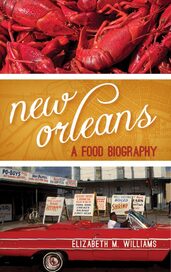
Food in the New American South
"The World in a Skillet: A Food Lover’s Tour of the New American South," by Paul and Angela Knipple...looks at the present with an eye on the future. It recognizes that the food of the South is a dynamic thing that changes with time and circumstances. It is a very important book.
The Knipples begin with a survey of Southern food, the early ethnic groups that contributed to it, and the practices, culture and technologies that have developed into what we think of as Southern. But then they take us into the modern world and remind us, through food, of what remains true. People from everywhere in the world keep coming to the South, and the South continues to absorb their food and identity as it has done in the past."
Excerpt from book review by Liz Williams, in SOFAB's Okra Magazine.
All About Sugar: Permanent Exhibit at SOFAB

Southern Food Acquires Collection
Longer de la Gueronniere
"We are excited to announce a new acquisition of the papers and books of Longer de la Gueronniere. The collection in French and in English includes recipes, autobiography and other papers. This is so exciting because, besides being a gourmet and expert entertainer with his wife, Ruth, he was one of the last commercial culinary connections post- World War II between France and New Orleans. Longer kept the culinary communication between France and New Orleans open as it was during the time of Degas and before that, Alciatore. Thank you to the family.
Oral histories will be added shortly."
Barb-e-que Nation, Too
